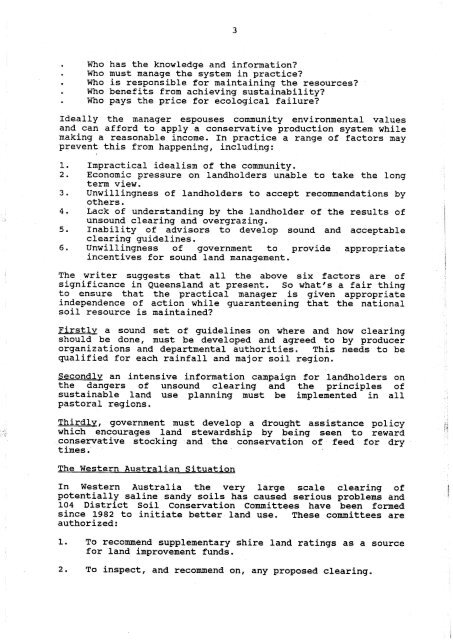soil-conservation-people-religion-and-land.pdf - South West NRM
soil-conservation-people-religion-and-land.pdf - South West NRM
soil-conservation-people-religion-and-land.pdf - South West NRM
Create successful ePaper yourself
Turn your PDF publications into a flip-book with our unique Google optimized e-Paper software.
. Who has the knowledge <strong>and</strong> information?<br />
. Who must manage the system in practice?<br />
. Who is responsible for maintaining the resources?<br />
. Who benefits from achieving sustainability?<br />
o<br />
Who pays the price for ecological failure?<br />
Ideally the manager espouses community environmental values<br />
<strong>and</strong> can afford to apply a conservative production system while<br />
making a reasonable income. In practice a range of factors may<br />
prevent this from happening, including:<br />
1. Impractical idealism of the community.<br />
2. Economic pressure on l<strong>and</strong>holders unable to take the long<br />
term view,<br />
Unwillingness of l<strong>and</strong>holders to accept recommendations by<br />
others.<br />
4. Lack of underst<strong>and</strong>ing by the l<strong>and</strong>holder of the results of<br />
unsound clearing <strong>and</strong> overgrazing.<br />
5. Inability of advisors to develop sound <strong>and</strong> acceptable<br />
clearing guidelines.<br />
6. unwillingness of government to provide appropriate<br />
incentives for sound l<strong>and</strong> management.<br />
The writer suggests that all the above six factors are of<br />
significance in Queensl<strong>and</strong> at present. So what's a fair thing<br />
to ensure that the practical manager is given appropriate<br />
independence of action while guaranteening that the national<br />
<strong>soil</strong> resource is maintained?<br />
Firstlv a sound set of guidelines on where <strong>and</strong> how clearing<br />
should be done, must be developed <strong>and</strong> agreed to by producer<br />
organizations <strong>and</strong> departmental authorities. This needs to be<br />
qualified for each rainfall <strong>and</strong> major <strong>soil</strong> region.<br />
Secondlv an intensive information campaign for l<strong>and</strong>holders on<br />
the dangers of unsound clearing <strong>and</strong> the principles of<br />
sustainable l<strong>and</strong> use planning must be implemented in all<br />
pastoral regions.<br />
Thirdlv, government must develop a drought assistance policy<br />
which encourages l<strong>and</strong> stewardship by being seen to reward<br />
conservative stocking <strong>and</strong> the <strong>conservation</strong> of feed for dry<br />
times .<br />
The <strong>West</strong>ern Australian Situation<br />
In <strong>West</strong>ern Australia the very large scale clearing of<br />
potentially saline s<strong>and</strong>y <strong>soil</strong>s has caused serious problems <strong>and</strong><br />
104 District Soil Conservation Committees have been formed<br />
since 1982 to initiate better l<strong>and</strong> use. These committees are<br />
authorized:<br />
1. To recommend supplementary shire l<strong>and</strong> ratings as a source<br />
for l<strong>and</strong> improvement funds.<br />
To inspect, <strong>and</strong> recommend on, any proposed clearing.
















